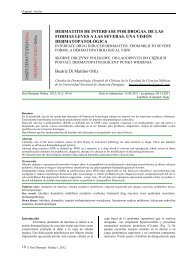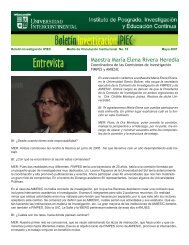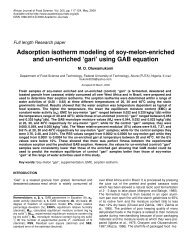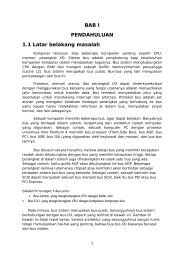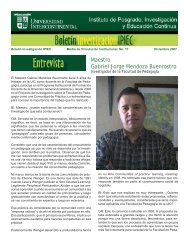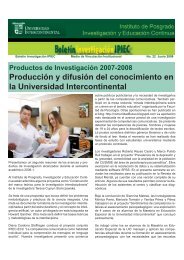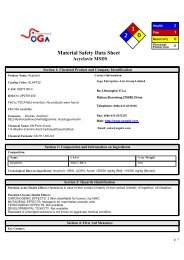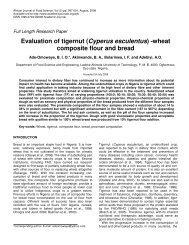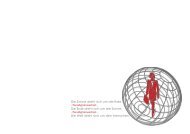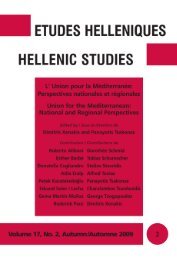Antimicrobial screening of stem bark extracts of ... - Science Stage
Antimicrobial screening of stem bark extracts of ... - Science Stage
Antimicrobial screening of stem bark extracts of ... - Science Stage
Create successful ePaper yourself
Turn your PDF publications into a flip-book with our unique Google optimized e-Paper software.
092 Afr. J. Pharm. Pharmacol.<br />
Table 4. Effect <strong>of</strong> temperature (°C) on antimicrobial activity <strong>of</strong> the <strong>extracts</strong> (50 mg/ml) <strong>of</strong> Vitellaria paradoxa<br />
Organisms<br />
Acetone <strong>extracts</strong> Water <strong>extracts</strong> Ethanol <strong>extracts</strong><br />
4 60 100 4 60 100 4 60 100<br />
*Ethanol<br />
Extracts<br />
*Acetone<br />
<strong>extracts</strong><br />
Klebsiella pneumoniae 7.0 10.0 12.0 7.0 7.0 10.0 8.0 10.0 12.0 8.0 7.0<br />
Proteus mirabilis 8.0 10.0 12.0 8.0 7.0 13.0 9.0 10.0 12.0 9.0 8.0<br />
Shigella dysentriae 8.0 10.0 12.0 7.0 7.0 10.0 9.0 10.0 10.0 9.0 8.0<br />
Escherichia coli 8.0 9.0 12.0 8.0 10.0 13.0 9.0 9.0 10.0 9.0 8.0<br />
Salmonella typhi 8.0 9.0 12.0 8.0 9.0 13.0 8.0 10.0 10.0 8.0 8.0<br />
*Untreated extract (ambient temperature 30°C)<br />
Table 5. Minimum inhibitory concentration (MIC) values <strong>of</strong> the <strong>stem</strong> <strong>bark</strong> extract <strong>of</strong> Vitellaria paradoxa<br />
Organisms<br />
MIC (mg/ml)<br />
Aqueous Ethanol Acetone<br />
200 100 50 25 12.5 6.5 200 100 50 25 12.5 6.5 200 100 50 25 12.5 6.5<br />
Escherichia coli + + - + + + + + - - - + - - - + + +<br />
Klebsiella pneumoniae + + + + + + + - - - - - - - - + + +<br />
Proteus mirabilis + + - - + + + + - - + + + - - + + +<br />
Shigella dysentriae + + - + + + - - - - + - - - - + - +<br />
Salmonella typhi + + - - + + + - - - - + + - - + + +<br />
Chloramphenicol - - - - -<br />
+ = presence <strong>of</strong> bacterial growth; - + = absence <strong>of</strong> bacterial growth<br />
Table 6. Minimum bactericidal concentration (MBC) values <strong>of</strong> the <strong>stem</strong> <strong>bark</strong> extract <strong>of</strong> Vitellaria paradoxa<br />
Organisms<br />
MBC (mg/ml)<br />
Aqueous Ethanol Acetone<br />
200 100 50 25 12.5 6.5 200 100 50 25 12.5 6.5 200 100 50 25 12.5 6.5<br />
Escherichia coli + + - - + + + + - - - - - - - + + +<br />
Klebsiella pneumoniae + + + - + + + - - - + + - - - + + +<br />
Proteus mirabilis + + - - + + + + - - - - + - - - + +<br />
Shigella dysentriae + + - - + + - - - - + - - - - + + +<br />
Salmonella typhi + + - - + + + - - - + - + - - - + +<br />
Chloramphenicol - - - - + -<br />
+ = presence <strong>of</strong> bacterial growth; - + = absence <strong>of</strong> bacterial growth.<br />
mm (zone diameter <strong>of</strong> inhibition) each against E. coli, S.<br />
dysenterie and, P. mirabilis; and 8.0 mm (zone diameter<br />
<strong>of</strong> inhibition) against K. pneumonia, but as the temperature<br />
was raised to 60 o C there was no significant change<br />
in activity (10.0 mm zone diameter <strong>of</strong> inhibition each)<br />
against all the test organisms. A similar trend was<br />
observed with the <strong>extracts</strong> <strong>of</strong> all the other solvents (Table<br />
4).<br />
The MIC and MBC values <strong>of</strong> the <strong>extracts</strong> against the<br />
test organisms ranged between 25-200 mg/ml for the<br />
water <strong>extracts</strong> and acetone <strong>extracts</strong> and 6.5 - 200 mg/ml<br />
for the ethanol <strong>extracts</strong> (Table 5 and 6). These values<br />
were to some extend comparable to those <strong>of</strong> chloramphenicol<br />
even though the antibiotic is in a pure state.<br />
DISCUSSION<br />
Preliminary phytochemical investigations <strong>of</strong> the <strong>stem</strong> <strong>bark</strong><br />
and leaves <strong>of</strong> V. paradoxa revealed the presence <strong>of</strong><br />
some phytochemical compounds. Phytoconstituents<br />
(alkaloids) has earlier been reported in different plants<br />
including the <strong>stem</strong> <strong>bark</strong> <strong>of</strong> Setigera and Nauclea latifolia<br />
(El-kheir and Salim, 1980; Tona et al., 1998). These<br />
secondary metabolites are linked to antimicrobial activity<br />
<strong>of</strong> the plant material. Drugs contained in medicinal plants<br />
are called active principles and these active principles are<br />
divided into a number <strong>of</strong> groups. Carbohydrates present<br />
in plants are mostly in the form <strong>of</strong> pentoses, sucrose and<br />
soluble sugars which are intermediate plant constituents



